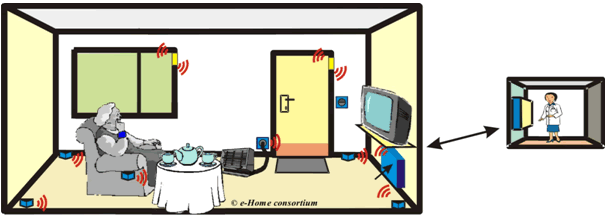Current Trends and Propositions for the LLM service
Driven by the ageing of the European population the need to support an independent, autonomous and safe living of elderly people in their own homes is becoming a big issue, which is also a challenge for research, development and industry. One approach to fulfil these needs is the deployment of ICT based assistive smart home solutions.
Industrial, national and also EC funded initiatives, such as FP6, FP7, ICT-PSP and AAL are putting a lot of effort into making homes smarter, more assistive and more enabling for the elderly. These current smart home solutions can serve as a real shelter for fragile older people: they feel protected by the monitoring and surveillance systems and care is provided when needed; they also feel protected against intrusion and fire; and feelings of isolation are reduces, since, for example, talk to individuals in the world beyond the boundaries of their home and access modern communication and information media.
Some examples of current home monitoring solutions are as follows: The American Telecare Monitoring Station is placed at the patient’s home to offer assistance with patient compliance and vital signs monitoring by collecting and transmitting health data to a doctor’s office. A two-way audio/video station combined with medical peripherals is also available to provide a real-time picture of the patient health status. Philips’ Motiva system, works around a patient’s television, in order to measure autonomy levels as well as vital signs, glucose management, etc. ADT’s WellHealth product suite, is designed to monitor health regimens and medication through the use of digital devices and networks that connect patients to ADT’s Customer Monitoring Centres and, if necessary, a medical professional. The Living Independently Group offers the QuietCare product, which works using presence sensors. Based on the recognition of events, this early detection and warning system lets caregivers and family members know that a loved one is safe. It recognizes emerging problems before they become emergencies.
The LLM Independent Living Component (ILC) is based on the eHome system, which consists of network of distributed sensors wirelessly connected to an embedded system and a local interface unit offering a simple to use intuitive graphical user interface. It includes features, such as intelligent learning of normal and exceptional patterns of behaviour, detecting dangerous situations, generating of alarms and communication and information access.
For the LLM service as the component for an independent living (ILC) the eHome system has been selected. The eHome system has been developed within an Austrian consortium (CEIT RALTEC, University of Technology Vienna, Treventus GmbH and Kapsch CarrierCom AG) with partial funding by the Austrian ministry of traffic, innovation and Technology (BMVIT) and the program management of the Austrian Research Promotion Agency FFG.
The eHome system is comprised of a network of distributed wirelessly operating sensor units connected to an embedded PC. It includes features such as intelligent learning of normal and exceptional patterns of behaviour and detection of dangerous situations, raising of alarms and operating an intelligent power outlet for controlling electrical devices like TV or radio . One of the main features of eHome is the detection of a person’s downfall. The main advantage, compared with other solutions, is that the elderly person using eHome does not need to wear any device on his/her body, as the monitoring is done by sensors placed in the end user’s home. These sensors are connected to a central unit through a wireless network. For privacy reasons, no cameras or microphones are used as part of the monitoring process and no monitoring data is transferred outside the elderly person’s home without the personal agreement of the senior end user. Additionally to these monitoring, alarm and control functions eHome offers on it local user interface LUI a state-of-the art touch screen PC voice & video telephony and web-access using an intuitive, focus group specific and simple to use graphical user interface.

In case of a detected dangerous situation like the fall down of a person the eHome system sets up automatically a telephone call to a predefined chain of different targets like a relative, a care person or an emergency call centre, controlled by an intelligent and advanced telecommunication server.
eHome can be easily installed in an elderly person’s home, at a day care centre or at a formal institution, since the wireless sensors are battery fed and no cabling is required.
The eHome remote user interface RUI gives remote access to care takers, relatives and technical support. It is a web-based interface for remote access via the internet. For care or medical experts it offers remote access to certain user data and to configuration of the system.
 Tags:
Tags: 


